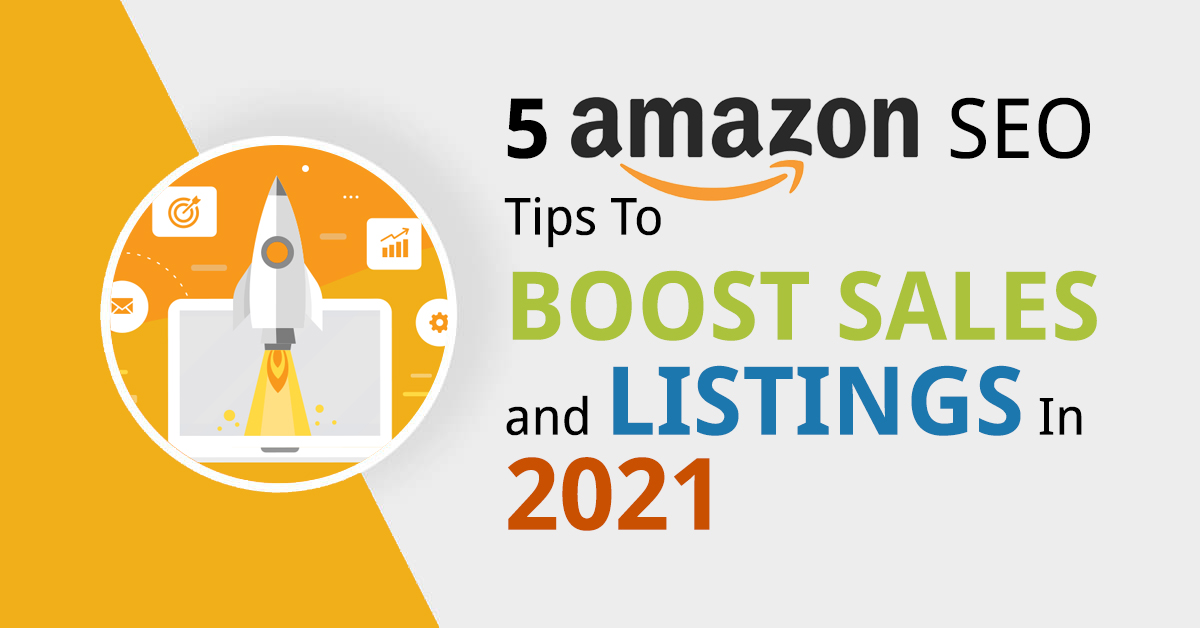
Amazon is, without a doubt, the trailblazer of the eCommerce industry. In recent years, the company has seen a monumental shift, driving the online retail industry to incredible heights.
Amazon’s global eCommerce sales will touch $416.48 billion by the end of 2020. This retail giant is one of the largest and fastest-growing retailers on the web. One thing that goes without saying is – Amazon sellers, in order to stand out and reach more customers, need to be well-acquainted with Amazon SEO or Amazon A9 algorithm.
You might think that Amazon SEO is similar to search SEO, but that isn’t true. Amazon is a completely different beast. The way people search on Amazon is different than Google, so there is a slight learning curve. There are a lot of misconceptions out there about Amazon SEO and how it works. But there’s nothing to worry; we’ve got you covered.
In this article, we will discuss:
- Amazon SEO
- Amazon A9 Algorithm
- The Top 5 Amazon SEO strategies
First things first,
WHAT IS AMAZON SEO AND HOW DOES IT WORK?
Amazon SEO involves optimizing your product listings for higher rankings in Amazon searches for related keywords. When you optimize your product listing, you make it easier for Amazon to find your listing and show it to shoppers who are looking for similar product(s).
It involves:
- Amazon keyword optimization
- Amazon product title optimization
- Amazon listing optimization
- Product image optimization
- Pricing strategy
- Amazon A9 algorithm
To make the best of your product listing and attain higher rankings, take assistance from expert Amazon listing optimization service providers.
WHAT IS AMAZON A9 ALGORITHM AND HOW DOES IT WORK?
A9 is the algorithm that Amazon uses for product searches. It is a ranking process that influences where products appear for a particular keyword on the Amazon search engine results page (SERP).
Though Amazon ranks products based on how likely the searcher will purchase the product, the question is how does the Amazon algorithm figure that out?
Firstly, Amazon analyses the keywords in the shopper’s search query. If your product listing doesn’t have keyword(s) in the search query, it probably won’t appear in the search results. Next, Amazon tries to assess purchase likelihood based on how well your product has performed in the past. To do this, the algorithm looks at the following metrics:
- Search result click-through-rate (CTR)
- Conversion rate on the product page
- Overall sales
There are chances that your product might get more clicks and conversions for one search query than others — for instance, if a shopper is looking for a specific color or size and your product matches that description, they’re more likely to click on (and buy) that product.
Now, let’s dive deep into the Amazon SEO strategy that will help you boost your sales in 2021 and beyond.
AMAZON SEO TIPS THAT DRIVE SALES AND CONVERSIONS
1. KEYWORD RESEARCH
If you’ve used SEO previously, you probably know about keyword research. With Amazon SEO, keyword research has some similar qualities to traditional SEO, but some buyer-focused attributes are an add-on.
Just like traditional SEO, you want to focus on long-tail keywords. When people search for products/services on Amazon, they generally use long-tail keywords to find their desired products. It is important for you to rigorously find relevant keywords. You don’t want to miss out on potential leads just because you missed out certain keywords in your Amazon product listings.
You can either take help from Amazon SEO experts or use online tools, specific to Amazon, for knowing the search volume for each keyword and prioritizing them in your Amazon SEO campaign. Once you have selected your keywords, integrate them into your listings and use them in the product titles/descriptions.
Pro-tip: Leveraging Amazon product data entry services can help you with keyword-rich and informative product descriptions that sell.
2. KEEP YOUR PRODUCT PRICING COMPETITIVE
Shoppers are always looking out for enticing deals when looking for favourite products on Amazon. It’s important for you to list your products at competitive prices, especially when your product range isn’t unique.
If you’re selling your product for $50 and your competitors have a similar product for $20 – $30, your Amazon SEO campaign won’t be effective. In fact, your product list won’t rank because it is too expensive. Your audience will choose a cheaper product that fulfils their needs. To have competitive listings, you need to monitor your competitor’s prices.
Pro-tip: You may hire Amazon VA or opt for Amazon SEO services from a specialized vendor. This will help you adjust the process in real-time and boost sales conversions.
3. OPTIMIZE YOUR TITLE
Your product title is the most essential and valuable part of your listing. The sole reason behind placing weight on this is that several shoppers just look at the title to make the buying decision.
The general format for creating a product title is:
- The brand
- The Product Line
- The material
- Key feature
- Product type
- Color
- Size
- Packaging/Quantity
This is the general rule of thumb for creating a product title. It might not apply to all the products, but you want to use the ones that do. The order of your title impacts how your audience finds your listings, so it is important that you stick to the proper order.
When you optimize your title, you want to place your most relevant keyword(s) first. This ensures that people always see your most important keyword, regardless of how short or long the title appears in the search results. It further helps your listings appear in the most relevant search results.
Pro-tip: That’s a lot of information to put in one title. The secret here is how you order them.
4. ENCOURAGE CUSTOMERS TO LEAVE REVIEWS
When it comes to driving sales, nothing could be more effective than leveraging customers’ reviews and ratings. As per a study, over 80% of customers trust online reviews as much as the personal recommendations given by a friend.
That being said, you should encourage customers to share their experience after making a purchase. When your audience leaves feedback, there’s a good chance you’ll receive negative reviews. As part of managing your reviews, you need to take the time to respond to negative reviews. It will prevent you from deterring future customers. Moreover, your response to negative reviews allows people to see how you address customer issues, offer to replace broken or damaged products, and respond to questions. Resultantly, they will feel more confident that your brand adheres to customer feedback and is trustworthy.
Pro-tip: If you struggle in getting reviews and ratings from your customers, you may seek help from an expert company that provides Amazon data entry services at reasonable prices.
5. OPT FOR AMAZON ADVERTISING
Regardless of your experience with the Amazon marketplace, advertising on Amazon is one of the easiest and effective ways to enhance your products’ visibility. When you go for Amazon advertising, your products start appearing just before the organic search results. This, in turn, accelerates your product sales and conversions.
The best part: Amazon advertising uses the PPC model, which means you just have to pay for the clicks on your ad and not for the number of impressions.
Pro-tip: If you are new to sponsored product ads, consider getting in touch with an Amazon PPC agency to optimize your ad campaign and make the most of it.
Ready to build your Amazon listings?
Make an impact by getting in touch with our Amazon SEO experts today at mail@quiktekinfo.com.


